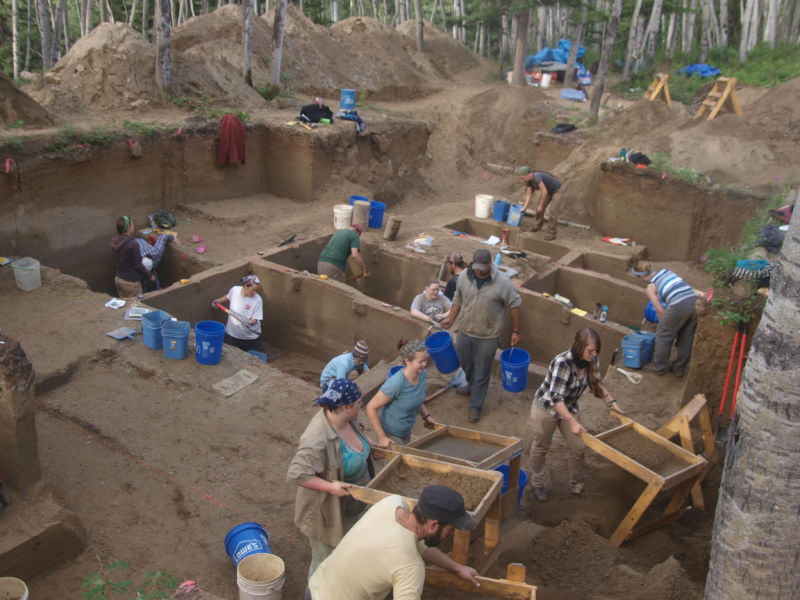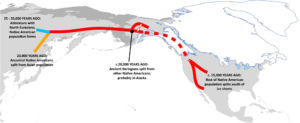
Where did Native Americans come from? Over the years, lots of ideas have been considered, but genetic data eventually came down decisively in favor of one of them. Native Americans are most closely related to East Asians and must have come across a land bridge that was present between Siberia and Alaska during the last glacial period.
But that big-picture answer has raised all sorts of additional questions about the details. There has been a long-running argument over their mode of travel, which only recently seems to have been decided in favor of boats. There are still arguments over how many waves of migration took place. And a weak genetic affinity for Eurasian populations, strengthened by an ancient Siberian genome, raises questions about how that DNA ended up in Native American genomes.
Now, a large team of researchers is saying they have data that clarifies a lot of these questions. It comes in the form of a genome obtained from a child's skeleton found in Alaska. The skeleton has been dated to 11,500 years ago, and the genome now suggests it represents a member of a now-lost population that occupied the Beringian land bridge at the peak of the last glacial period—and gave rise to Native Americans.
Meet the ancestors
The skeleton was found at a site called Upward Sun River and was one of two child skeletons found buried there (the second did not yield any DNA that could be sequenced). The site is located in the Alaskan interior, along a river that flows into the Yukon. It would have been north of the massive ice sheets that formed during the last glaciation.
The genome itself looks almost exactly like you'd expect given a migration along the land bridge, either by foot or boat, prior to the end of the glaciation. It's equally related to all Native American populations but lies closer to the base of that branch of the human family tree. In other words, it is more similar to what we'd predict the ancestor of all Native Americans would look like, genetically.
So, it's located in a spot on the family tree that's very informative. Plus it comes with a precise date, which allow us to determine the timing of various events, like migrations and interbreeding. Using that information, the authors reconstruct the history of Native Americans.
The data suggest that the ancestors of Native Americans branched off from other East Asian lineages starting at about 35,000 years ago, although the groups continued to interbreed for another 10,000 years. At about the time that stopped, the Native American ancestors started interacting with a Eurasian population in Siberia. That stopped by about 18,000 years ago. From then on, the population was isolated.
From Beringia to the Americas
How did this isolation take place? The authors argue that the separation from East Asian populations occurred due to the onset of the Last Glacial Maximum 24,000 years ago. This was the final exceptionally cold period before the glaciation came to an end. It would have led to expanded ice sheets in Siberia that could have closed the Native American ancestors off on the east side of an icy wall, and indications are that human presence in Siberia dropped during this time. Although there are small regions of Siberia that would have been habitable, the authors argue that it's likely that this population was already occupying the land bridge but was blocked from continuing beyond Alaska by other ice sheets. (This "isolation on the land bridge" hypothesis has been called the "Beringian standstill.")

All indications are that Native Americans had made their way to the North American interior by 15,000 years ago, and the new data suggest they started to split off from other Beringians as early as 20,000 years ago. Since the new Beringian genome is equally related to both northern and southern groups of Native Americans, the authors argue that the migration into the interior probably took place in a single wave by an ancestral Native American population. The split into northern and southern groups would have happened once they were in the interior, since the team calculates the split at somewhere between 17,500 and 14,500 years ago.
The authors' favored model isn't definitive. It's possible that the Beringians remained in northeast Siberia, rather than expanding through the land bridge and into Alaska, until relatively recently. It's also possible that the northern and southern Native Americans had already diverged before they made their way into the interior of the Americas. But the researchers persuasively argue that their model is the simplest explanation for all the data we have at the moment.
Epilogue
The child's burial took place in the Alaskan interior, north of the ice sheets, after the ancestors of Native Americans had already made their way south. But there's no sign of any Beringian heritage among modern-day Alaskans. Instead, Alaskan natives all appear to be derived from a group of Native Americans who migrated back north after the ice sheets collapsed (some of this population would go on to interact with Siberians and Inuit, complicating the picture somewhat).
All of which indicates that the child was probably one of the last of her lineage. After having survived the Last Glacial Maximum on the harsh tundra of Alaska, the Beringian lineage came to an end as the climate warmed up.
Nature, 2017. DOI: 10.1038/nature25173 (About DOIs).
You must login or create an account to comment.